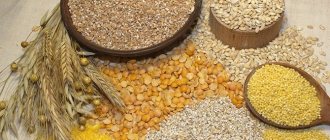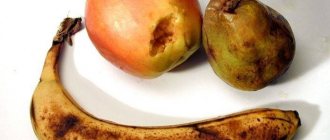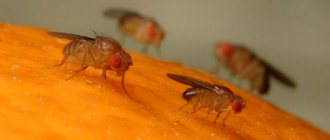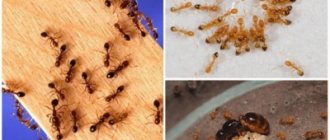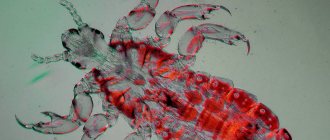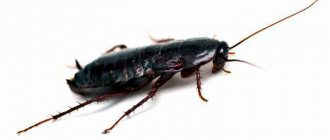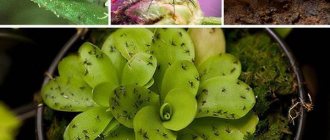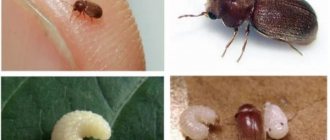How to save dried fruits from moths
In order to enjoy compote from dried apples or pears all winter, you need to think in the fall about how to preserve dried apples from moths. You should use a few simple tips:
- Packages in which you plan to put dried apples must be hermetically sealed. After storing last year's harvest, these dishes must be disinfected;
- Dried fruits should not be stored in pouches - the materials from which they are made are not strong enough. All it takes is the slightest hole for insects to enter. Dried fruits do not “breathe”, lose their aroma, and wither;
- The optimal storage method is glass, wooden or metal containers with a tight-fitting lid, or thick linen bags. The inside of the containers should be covered with paper. A dry sheet of paper should be placed on top of the sprinkled dried fruits (change it regularly so that it is not wet).
It is much easier to store dry apples in a container or bag - they can be conveniently placed inside wall or floor cabinets and shelves
It is important to monitor air humidity to avoid mold growth. The cabinet must be regularly ventilated, maintaining dry air, and treated with a weak solution of vinegar
No matter how well the drying is packaged, you should inspect it regularly in case a pest was able to get into the supplies.
It is very important that the dryer is processed after each serving of fruit. In winter it should be stored separately from food
Like other insects, moths are afraid of the smell of certain plants: laurel, lavender, oregano and acacia, so the fight should include using this “weakness”: placing parts of these plants next to packaged apples. It is permissible to replace them with citrus peels, the smell of which is also unpleasant for winged parasites. The basic rule is not to put odorous mixtures in a container with dried apples, otherwise foreign odors will be absorbed.
Moth repellents in dried apples
In summer, storing dried apples at home is somewhat easier, since you can take them out onto the balcony. To preserve all the taste properties and protect them from damage by food moths and other insects, it is recommended to put dried fruits in wooden boxes and cover them with several layers of gauze - this way the apples can breathe.
Prevention methods
Preserving dried fruits from moths at home is quite difficult, but if you wish, you can avoid troubles.
- Store dried fruits in places with bright sunlight or in a room with low temperatures.
- Periodically sort through the supplies and heat in the oven for a few minutes.
- Wipe cabinets with water and vinegar or place repellents. The moth is afraid of a pungent odor, but with constant presence it gets used to it, so protection should be alternated.
- Place special traps, tablets, cassettes against moths and their larvae next to dried fruits.
You need to begin active actions immediately after discovering at least one moth or caterpillar. Knowing what moths are afraid of, you can quickly eliminate the problem. Otherwise, all food supplies will be contaminated, which will then have to be thrown away. Due attention should be paid to proper storage of dried fruits.
Preventive measures
We told you how to deal with pest infestation in the pantry if they have already infested. But to prevent this from happening, it is easier to prevent their occurrence by fulfilling simple requirements:
- To prevent an adult insect (2.5 cm) from entering the room, you need to protect all ventilation windows with fine mesh grilles;
- do not buy goods by weight in the markets; vacuum packaging does not give the insect a chance of survival;
- have a separate storage container for each type of dried fruit;
- constantly check the stock status;
- if possible, immediately after purchase, dry the fruits in the oven with the door open;
- do not make large purchases of dried fruits; small stocks can be stored in the refrigerator;
- The pantry must be frequently ventilated and kept clean and tidy.
Advice. To repel moths, you can use folk remedies: tobacco, dried lavender, and from ordinary means - fumigators or traps.
The food that comes to our table brings us energy - to live and work, vitamins and microelements - to be healthy and beautiful, pleasure - to remain satisfied with our fate. But food with a wormhole can destroy all this forever, ruin it. Someone said, cleanliness is the key to health, so take care of this guarantee, and keep food supplies clean, be healthy.
Features of the insect
Getting rid of fruit moths is difficult - this voracious insect is not so easy to detect at the very beginning. The fact is that adults are already flying around the kitchen, but they don’t eat anything at all. Their main goal is to find a secluded place and lay eggs there, from which moth larvae will hatch in a few days. It is they who turn delicious dried fruits into real dust.
You can recognize fruit moths by the characteristic stripes on the tips of their wings. It is small in size, only about 1 cm long. Look at what the fruit moth looks like in the photo, so that if it appears, you can identify the enemy by the appearance of the moth butterfly. The grown larvae can be seen with the naked eye; they do not look like small worms. They hatch from eggs hidden in a cocoon, as if made from a cobweb.
food moth
Fruit moths can appear not only in dried fruits. An excellent habitat for it are bags of cereals or flour. Moth larvae prefer to eat sweet fruits, but the butterfly can lay eggs in a dry place next to them, and the hatched larvae will crawl to the delicacy on their own.
Fortunately, they do not crawl long distances, so fruit moths can appear in an apartment only in one of the following ways:
- fly through the ventilation ducts and settle in the food cupboard;
- entering the house with a new batch of low-quality dried fruits;
- fly into an open window, especially in the evenings when the lights are on in the windows.
Therefore, it is quite possible to protect yourself from its appearance and it is much easier to do than getting rid of moths in dried fruits.
What bugs are found in cereals and flour?
Cockroaches at home cannot start just because the housewife has a shelf with cereals in her apartment. And they are stationed in other places. Their favorite places are where food scraps can be found. Therefore, they live near sinks and sinks, kitchen stoves, window sills and waste bins. But if there is cereal or other foods along the cockroach’s route, they will not refuse the meal. There are cockroaches in cereals and flour, provided that they have already settled in the house before.
In cereals and flour there are:
- Bread grinder. Small brown beetle. May have brownish-brown tints. They are about 3 mm long, but can fly. Due to the fact that it is often found in medications, it is also called “Pharmaceutical”. Not afraid of sunlight. It starts mainly in bread, but as it multiplies it affects everything, from food to furniture and household items.
- Flour beetle. It is called the small hruschak because of its small size. The maximum size is 3 mm. It looks like a regular beetle and has wings and antennae. However, he does not use his wings for their intended purpose. Painted red-brown or dark brown. Favorite foods are cereals and flour, but he does not disdain other products. Particularly dangerous due to the fact that it is extremely difficult to remove. Its second name is Mukoed Suriname.
- Red flour eater. A bug that loves flour. The fight is made difficult by the microscopic size of the pest - 1.5 mm. There are large specimens up to 2.5 mm in size. Lives in grain industry enterprises. But it will not start in flour stored at the required temperatures and humidity levels. It has a yellowish tint, similar to rust.
- Food moth. It may simply fly out the window, finding food to settle and reproduce. Has wings and can fly. The length of its body is 10 mm. Prefers bulk products, grains, raisins, dried apricots and prunes. It reproduces quickly with the help of laid larvae that grow into caterpillars. The caterpillars, in turn, become butterflies.
- Weevils. They have a large size for bugs - 5 mm. They can fly and have a high reproduction rate. Their favorite food is rice, which is why the pest is called rice weevil. But pests easily consume any cereal and even fruit crops.
- Southern barn moths. Another representative of butterflies. They enjoy nuts or dried fruits.
Once inside the house in a purchased package, pests quickly occupy food shelves, instantly multiplying. Due to their small size, they hide well in cabinets and bags.
Folk remedies
The use of chemicals in the kitchen to combat insects is extremely undesirable, as there is a risk of poisoning the products, and through them, people. Therefore, many are looking for alternative ways to fight. There are many folk remedies for fighting fruit moths. You can use several methods at once or choose one that works most effectively.
- Moths do not like the smell of garlic. Therefore, you can place peeled fresh cloves of this vegetable in your cabinets. It must be borne in mind that gradually the moth gets used to it and stops reacting to such an aroma. Then we need to move on to other methods of scaring.
- In the same way, the smell of lavender, wormwood, peppermint, catmint, oregano, and sweet clover will repel insects. You can hang bunches of herbs in the kitchen or place bags of these aromatic herbs in the cabinets.
- Bay leaves and cloves also help get rid of moths. You can put laurel leaves on top of jars of cereals. Then the insect will not lay eggs in these containers.
- It has long been noted that the smell of citrus fruits repels moths. Do not throw away the peels of oranges and tangerines. It should be dried and the peels should be placed in jars and bags with dried fruits, cereals, flour, and simply placed on the shelves of cabinets where food is stored.
Fruit moths easily adapt to odors and stop reacting to them. Therefore, you should not immediately use all of the listed means - it is better to use them in turn, periodically changing one to another.
What to do if dried fruits are contaminated?
If there are moths in dried apples, you need to take urgent measures to save the remaining stocks. Otherwise, these insects can completely spoil all products. The situation can be corrected only if the damage is minor, otherwise the dried fruits should be thrown away.
Heat treatment
If adult flying individuals were found in the house, but their worms are not visible in the product, then heat treatment can be carried out for drying. To do this, you need to pour it onto a baking sheet and heat it in the oven at +60...700C for 40 minutes.
This pest does not tolerate low temperatures. Therefore, to save drying, you can place it in the freezer and leave it for a day.
Using improvised means
The means at hand will also help to cope with the problem. If there are moths in dried fruits, you need to dispose of spoiled products, and prepare special traps for adult moths. To do this, you will need to mix boric acid with flour in a ratio of 1: 3. Place the resulting mixture in separate containers and place them on the shelves of a cabinet or pantry.
Folk methods of struggle
In the fight against pests, you can also use folk remedies, especially since it is not always advisable to use chemicals in the kitchen next to food.
Effective ways to get rid of moths:
- Lavender. Place bunches of this herb on shelves where dried fruits are stored.
- Citrus. To repel the pest, chop the fruit peel and place it next to the drying container. It needs to be updated periodically.
- Vinegar. Dilute it with water at the rate of 1:3. Wipe the inside of the cabinets where the product is stored with the resulting composition.
Lavender
Protection of dried fruits
If moths have already laid eggs in pieces of fruit, the product will have to be thrown away. It will be necessary to carefully examine the grain, flour, pasta, and cereals standing nearby, since food moths and its varieties can also be found there: flour, fruit, grain. If worms are crawling in some of these products, all these packages must also be thrown away.
If there are few larvae, you can fight for food. Like all insects, moths are afraid of low or high temperatures. Therefore, dried fruits, carefully selecting spoiled slices, need to be dried in an oven heated to 70 degrees for half an hour.
You can also kill moths and their larvae with frost: simply take dried fruits out onto the balcony in winter or leave them in the freezer overnight.
Food moths and their larvae prefer high humidity and warmth. It is difficult to take her out of a home where conditions suitable for her are maintained. The ideal way to get rid of moths is through thorough ventilation, drying corners, and eliminating damp foods.
Sometimes housewives prefer to use chemicals, but this method will not get rid of moths for long. Knowing how to deal with food moths, you can protect your supplies from voracious pests and cook apple compote for your children all winter.
Knowing how to deal with food moths, you can protect your supplies from voracious pests and cook apple compote for your children all winter.
Harm caused
It doesn’t matter what type (barn moth, cereal moth, flour moth, nut moth, fruit moth) has settled in your kitchen, the harm is the same. In any case, you need to get rid of it as soon as you notice the first butterflies.
Food moths eat almost everything - the larvae are found in cereals, sugar, flour, bread, dried fruits, nuts, dried mushrooms, tea, pasta, seeds, and pet food.
In addition to eating, the larva weaves cocoons from silky threads reminiscent of a spider's web. They look like wool balls and pellets. She sheds her skin several times, changing her skin. Don't forget about defecation products and dead larvae.
All this makes food unsuitable for consumption unless you want to develop severe intoxication, a severe allergic reaction, problems with the immune system, or cause other harm to the body.
Adult butterflies, constantly flickering before your eyes, have the unpleasant property of getting into cups of drinks and pots when cooking.
The longer you wait, the harder it is to get them out later.
Where does it come from?
Food moths can get into a person’s home in different ways. Pest larvae may already be in products purchased in stores, since storage conditions in warehouses do not always correspond to the norm. And this leads to the proliferation of the pest. In the absence of dried fruits, moths appear in cereals, flour, tea and nuts. The only things that don't appeal to her are spices and coffee.
Pupae of the pest may also initially be found in fruits that have been used for drying. And since they are subsequently stored in a dry, dark place, such conditions are ideal for further reproduction.
Moths can also fly in through an open window at night. As a result, she finds a favorable place and lays eggs.
How to store your own dried fruits
Experienced housewives, who have never thrown away spoiled fruits, try to prepare them on their own and preserve them for a long time. To ensure that they are stored properly and for a long time, we recommend taking certain measures.
Store different fruits and nuts in separate containers
Drying rules and preparation for storage:
- To ensure that fruits dry evenly, you need to cut them into equal pieces or slices.
- During the drying process, the finished dried fruits are put in a cooler place, the remaining chopped fruits are turned over and tossed, bringing them to the required drying.
- Select storage containers that are hermetically sealed: dense but breathable bags, containers with lids or glass jars.
- Before packaging, the containers must be sterilized; containers, if they are not heat-resistant, are disposable.
- Fill them with dried fruits to 2/3 of the height, leaving room for air.
- Containers are stored at a temperature of about +10 degrees.
During the entire storage period, it is necessary to check the condition of the product, taking into account humidity and the presence of pests. The main insects that attack dried fruit are fruit moths and aphids.
Description of fruit moth
The fruit moth is a small and unremarkable butterfly: its body is approximately 1 cm long, and there are horizontal stripes on its gray wings and body, slightly different from the main color. It is easier to notice the pest in the evening, because the insect is characterized by a nocturnal lifestyle. Active years begin in the dark, while during daylight hours the insect prefers to hide in secluded corners, and you can see the fruit striped moth only by accident, for example, by opening a cabinet with supplies where it is hiding.
The life of an insect is short: it lasts on average 2–14 days. The female dies after laying eggs in food. Soon, voracious larvae will hatch from the clutch, which harm the food. Adults do not feed, so they pose a danger only as continuers of offspring.
Why is an insect dangerous?
The places where moths live are not only the kitchens of residential buildings, but also warehouses, where they eat all poorly sealed cereals. An unscrupulous manufacturer, having discovered insects in a product, knows that selling it even after careful selection is impossible, so he makes a significant markdown. By purchasing goods in stores at a reduced price or on promotions, the consumer risks bringing unfortunate parasites into the house. They do not pose any direct danger to human health.
However, irreparable damage is caused to food supplies, and few people will be pleased to find the corpse of an insect or its larva in a cup of tea or a vase of jam. In dry foods, cereals, dried fruits, the process of moth degeneration occurs, that is, it not only eats them, but lays eggs, which then turn into larvae, which are considered the main eaters of human food.
This entire life process takes place in the kitchen in food products, from which food is then prepared. But they are no longer suitable for consumption, as they are contaminated with live and dead moth larvae, the remains of adult individuals, and feces. After damage to insects, no one eats food anymore.
An adult moth eats practically nothing - it is a light brown or grayish butterfly measuring 9-10 mm. The larvae are translucent caterpillars, up to 2 cm in length.
It is quite difficult to kill an insect with cotton, since it not only eats quickly and randomly, but also moves through the air, usually under the ceiling. Pests enter the active phase at night, during a safer and freer period for movement. At this time she eats everything. The food moth lives for no more than three weeks, but it is not advisable to hope for its disappearance and do nothing, because during this time it will leave a countless legacy in the kitchen as a gift.
Lifestyle and reproduction
It is not difficult for fruit moths to get into an apartment: you can hardly notice its clutches in a package with the coveted dried fruits. In nature, it lives in the tropics, so it definitely won’t fly in through a window or ventilation. But in large warehouses, where the assortment is represented by nuts, apples, and dried fruits, this is a frequent guest.
True, given the huge number of related species, some other species that flew through a window or escaped from neighbors through the ventilation system could easily settle in a bag of dried apples or nuts.
One fruit moth butterfly can lay up to 350 eggs, from which white larvae hatch. Quite often they can be found in dried apricots or figs, but home-dried apples are also susceptible to this scourge.
What does this butterfly eat?
Fruit striped moths can lay eggs in any food; the larvae can feed on nuts, seeds, and cereals. Since dried fruits contain sugar, that is, a substance that is most easily digested, she prefers bags and jars with dried fruits for her offspring as the main place for nursing. As soon as the larvae hatch, they immediately begin to eat dried fruits, gnawing holes in them. During the growth process, molting products - chitinous scales, toxic substances of vital activity, thereby clog dried fruits from the inside. Therefore, such dryings, after the appearance and detection of these parasites, are thrown away. Eating them is dangerous - you can get seriously poisoned.
Larvae or eggs of fruit moths may end up directly on the surface of the shelf and if other food products appear in this place, uncollected parasites can also infect them
That's why it's so important to get rid of them as soon as possible.
Dried fruits affected by moths should be destroyed immediately
How to get rid of moths
If there are moths in dried fruits and cereals, first of all you need to check all the contents of the cabinets and get rid of all food packages where they were found. After this, you need to thoroughly wash the cabinets with soapy water and vinegar.
To repel insects in the future, all surfaces of the cabinets can be wiped from the inside with a vinegar solution, especially carefully treating the joints of the walls. There is no need to spare money. It is best to use a strong vinegar solution - essence. To avoid chemical burns, handle surfaces using rubber gloves. After this, ventilate the room thoroughly for an hour.
There are effective means to combat moths - Raptor moth traps, Aeroxon and adhesive tapes. When installing traps, care must be taken that they do not come into direct contact with the products.
You can learn how to use chestnut to fight moths.
Fighting methods
If the presence of fruit moths is detected, it is not recommended to use chemicals against them, because harmful components can cause damage to the human body. It is necessary to carefully check all the bags and vessels in the closet where the moth left its offspring.
After the audit has been carried out, the closet or other storage must be completely emptied and vacuumed. Next, you should take a strong vinegar solution (essence) and carefully wipe the walls of the storage room with it, especially in the corners and joints.
If at least one larva is found, then you need to throw away the entire grain.
Do not forget that this product has a very harmful effect on the skin, so the use of gloves is mandatory. It will not be superfluous to protect the airways with a gauze bandage. Upon completion of the procedure, the room is ventilated for an hour. There are special chemicals against moths: traps, adhesive tapes and aerosols.
Their effectiveness is not inferior to vinegar, but the safety of food storage leaves much to be desired. When installing traps and tapes, you must ensure that they do not come into contact with food storage containers.
To ensure that the problem with fruit moths disappears from your home, you should take a number of certain actions:
- Rinse the jars with vinegar and wipe the bags with it. The use of chemicals in this case is strictly prohibited.
- It is advisable to leave the cereals in the microwave or oven for 10 - 15 seconds at a temperature of +50...+70 °C.
- If the damage is high and the entire kitchen or pantry is affected by moths, the room should be completely disinfected. Non-professionals should not do it, as they may get poisoned or the effect will be insufficient. It is highly recommended to contact an exterminator.
- You should contact a pest control service if the vinegar procedure does not produce results.
It makes no sense to repeat it again, since the larvae can acquire immunity to this substance. For more information about food moths, watch this video:
The only thing that can help is powerful chemicals.
Actions to take when a pest is first detected
Moths do not appear on their own. Most often, you yourself bring it into your home with food; less often, an adult may fly into a window or an open door. As a rule, contamination occurs as a result of violation of the storage conditions of the product, and this can happen both in the factory warehouse and in the store itself.
- If you purchase dried fruits in original packaging, then carefully check its integrity before purchasing. If you find even one minor hole, set the product aside.
- But since dried fruits are often sold by weight, you need to carefully sort them out when you get home.
- If you haven’t purchased dried fruits for a long time, but butterflies still appear, then sort out the dried fruits that have been stored for quite a long time.
- If you find even one larva, you must throw away the entire batch of product. The rest of the small caterpillars may be hiding inside the fruit, and you simply won’t see it. In addition, the product will be contaminated not only with maggots, but also with eggs, and by throwing everything in the trash, you will be able to avoid contaminating other food products in your kitchen.
- If there are no signs of fruit moths, the contents of the package must be transferred to glass jars and tightly closed with a lid.
We talked in detail about moths in cereals and the fight against them in a separate article: How to get rid of cereal moths?
How to prevent damage
It's a shame when a lot of food goes to waste. To prevent this from happening, you must follow a few simple rules. Below are the rules by following which you can get rid of food parasites and avoid unexpected losses:
- Store products in tightly closed jars.
- Prevent fruit moths from appearing in your home. Destroy physically!
- Place pots of geraniums on the windows. The essential oils released by this plant repel these insects.
- Periodically check the food in the kitchen and pantry. Contaminated products are a source of parasite spread. Such products are simply thrown away.
- Wipe shelves with vinegar solution. Vinegar destroys the eggs of this insect. As a result, the probability of larvae appearing drops to zero.
The fruit moth reproduces very well: it lays many eggs, the larvae grow quickly and new individuals emerge from them.
Prevention
Moths can enter human habitation in a variety of ways. Favorable conditions contribute to the fact that even several adult individuals can breed into entire colonies in the shortest possible time. There is no 100% way to protect your home from moths.
But if you carry out simple prevention and follow the advice, you can reduce this risk to a minimum:
- It is advisable to have a fine mesh on windows and hoods, through which pests will not be able to enter the room.
- You should buy products from trusted stores in order to exclude the possibility of introducing insects from outside. Also, before purchasing, you must visually check the packaging for leaks.
- It is better to store food supplies not in packages, but pour them into glass, tightly closed containers.
- From time to time it is necessary to wipe the shelves with water and vinegar or essential oils.
- The food storage area must be dry and ventilated.
- It is better to store nuts or dried fruits in glass containers that are hermetically sealed.
- And in general, it is better to keep the kitchen and dry fruit storage areas clean. This will prevent the appearance of not only moths, but also other insect pests.
Fighting methods
To destroy food moths, first of all, you should pay attention to gentle methods. It is not recommended to immediately use insecticides in the kitchen, as there is a possibility of the chemical getting on food
First, try traditional methods that can not only get rid of pests, but also prevent their reappearance.
Heat treatment
Once you have discarded all contaminated dried fruit, the remaining fruit can be heated at relatively high temperatures. To carry out this operation, the fruits are freed from packaging and laid out on a baking sheet. Set the temperature in the oven to no less than 50°C and no more than 70°C and heat the product for 3 hours.
At the end of the procedure, the fruit must be placed in glass containers with a hermetically sealed lid and put in the refrigerator or on a shelf in a cabinet. When you notice that adults stop appearing, the products can be returned to their permanent storage location.
Using improvised means
For the second method you will need:
- soap solution;
- table vinegar;
- lemon, eucalyptus or peppermint essential oil;
- Bay leaf.
The process sequence is as follows:
- completely empty wall cabinets, bedside tables and pantry of food and any objects;
- using a small vacuum cleaner attachment, treat the interior surfaces of the cabinets;
- Using a soft sponge soaked in a hot soapy solution, wipe the shelves, doors, hinges and corners of the furniture;
- containers intended for dried fruits must also be treated with soap and water;
- dry everything thoroughly and wipe with vinegar, to which you should first add a few drops of essential oil;
- Place a bay leaf on the bottom of each container.
Moth in dried fruits - what to do?
A small butterfly flying through your kitchen is a serious enough reason to start worrying about the safety of your food.
Most often, parasites feed on cereals and grains; moths are also often found in dried fruits. These insects feed while at the caterpillar stage, making small holes in dried fruits and entangling themselves in a silk cocoon. If the product is massively contaminated, it will be quite difficult to remove the moths
External characteristics
If you have observed repeated appearances of butterflies over the course of three weeks, this is evidence that the infestation is quite serious and it is necessary to immediately take steps to eliminate the insects.
Adults are characterized by small sizes and wings of a bronze or gray hue, with a span of up to 1.5 cm
The winged moth is no longer capable of causing any harm, since their oral organ is reduced upon reaching sexual maturity. Parasites are their larvae, which, having powerful jaws, feed quite intensively and accumulate energy reserves so that upon reaching the adult stage they have the opportunity to reproduce.
Food moth larvae are colored light pink or light yellow.
The caterpillar's head is brown. As a rule, infestation of dried fruits and vegetables with this type of moth will be indicated by small, neat nests and a thin cobweb around them. The larva will be inside the nest.
Actions to take when a pest is first detected
Moths do not appear on their own. Most often, you yourself bring it into your home with food; less often, an adult may fly into a window or an open door. As a rule, contamination occurs as a result of violation of the storage conditions of the product, and this can happen both in the factory warehouse and in the store itself.
- If you purchase dried fruits in original packaging, then carefully check its integrity before purchasing. If you find even one minor hole, set the product aside.
- But since dried fruits are often sold by weight, you need to carefully sort them out when you get home.
- If you haven’t purchased dried fruits for a long time, but butterflies still appear, then sort out the dried fruits that have been stored for quite a long time.
- If you find even one larva, you must throw away the entire batch of product. The rest of the small caterpillars may be hiding inside the fruit, and you simply won’t see it. In addition, the product will be contaminated not only with maggots, but also with eggs, and by throwing everything in the trash, you will be able to avoid contaminating other food products in your kitchen.
- If there are no signs of fruit moths, the contents of the package must be transferred to glass jars and tightly closed with a lid.
The photo below shows how to protect food, in particular cereals, from parasite invasion. We talked in detail about moths in cereals and the fight against them in a separate article: How to get rid of cereal moths?
Use glass containers for all foods that may harbor food moths.
Fighting methods
To destroy food moths, first of all, you should pay attention to gentle methods. It is not recommended to immediately use insecticides in the kitchen, as there is a possibility of the chemical getting on food. First, try traditional methods that can not only get rid of pests, but also prevent their reappearance.
Heat treatment
Once you have discarded all contaminated dried fruit, the remaining fruit can be heated at relatively high temperatures. To carry out this operation, the fruits are freed from packaging and laid out on a baking sheet. Set the temperature in the oven to no less than 50°C and no more than 70°C and heat the product for 3 hours.
A microwave oven can be an analogue to an oven.
At the end of the procedure, the fruit must be placed in glass containers with a hermetically sealed lid and put in the refrigerator or on a shelf in a cabinet. When you notice that adults stop appearing, the products can be returned to their permanent storage location.
Using improvised means
For the second method you will need:
- soap solution;
- table vinegar;
- lemon, eucalyptus or peppermint essential oil;
- Bay leaf.
The process sequence is as follows:
- completely empty wall cabinets, bedside tables and pantry of food and any objects;
- using a small vacuum cleaner attachment, treat the interior surfaces of the cabinets;
- Using a soft sponge soaked in a hot soapy solution, wipe the shelves, doors, hinges and corners of the furniture;
- containers intended for dried fruits must also be treated with soap and water;
- dry everything thoroughly and wipe with vinegar, to which you should first add a few drops of essential oil;
- Place a bay leaf on the bottom of each container.
Prevention
Having completely gotten rid of moths in dried fruits, you need to think about preventive measures. To prevent the parasite from returning to your kitchen, you can do the following:
- try to constantly maintain perfect cleanliness in the kitchen, which will prevent the appearance of not only moths, but also other insects;
- store food only in closed glass containers;
- it is better to cover hoods and vents with mesh to avoid the penetration of parasites from neighboring apartments;
- When you come home from the store, always check your food products - sort through dried fruits, add grains.
Now you know how to recognize fruit moths, remove them and prevent their reappearance. Remember that food parasites will only fly in the kitchen.
If you notice small butterflies in the closet, then this is a completely different type of pest, which you can learn about from other articles on our website.
For example, if you want to protect your winter wardrobe from small pests, we recommend reading the article: What means can you use to protect your fur coat from moths?
Source: https://BeetleStop.ru/mol-v-suhofruktah/
Methods of pest control
To save your supplies, you need to know how to get rid of fruit moths in your home. Fighting insects is not easy, because you cannot use the most effective means - chemical insecticides. They are toxic, therefore the treatment of food with pesticides is strictly prohibited: this can cause severe poisoning in humans.
Therefore, it remains to use harmless means. Traps and adhesive tapes designed to kill flying insects can help reduce the number of adult fruit moths in your home and prevent them from laying eggs. They should be placed near where dried fruits are stored, for example, near a cabinet or pantry.
First actions
As soon as larvae are noticed in food, you need to immediately take measures to prevent other food supplies from being damaged:
- Anything that turns out to be infested with pests must be thrown away without regret, because such dried fruits are unsuitable and even dangerous for consumption.
- It is necessary to treat the jars in which the food was stored with a vinegar solution.
- Also, vinegar essence is used to treat the shelves and walls of the cabinet with affected dried fruits. If there are eggs or larvae left there (they may be in crevices and hard-to-reach places), they will infect new products that they put in the cabinet.
Thorough treatment with vinegar essence should be carried out with gloves to avoid chemical burns to the skin of your hands. It is better to leave the vinegar on surfaces for up to half an hour to ensure complete destruction of pest residues. The substance has an unpleasant odor, so you need to leave the cabinet to ventilate with the window open until the excess aromas disappear.
Folk remedies
Over the entire history of human struggle against pests, folk remedies for fruit moths have been developed. They are simple, easy to use and, most importantly, safe for health. After all, these are natural products whose smell is unacceptable to most insects.
Effective against fruit moths:
- Lavender. The grass has a strong aroma, which is not tolerated by all moths, including fruit moths. Therefore, fabric bags with dried lavender have long been placed in closets to protect clothes and food supplies from this insect. Alternatively, you can use dried mint and lemon balm, which also have a rich scent.
- Bay leaf. A few leaves placed in the closet will repel the pest. But the effectiveness of laurel is lower than that of lavender.
- Citrus zest. It is saturated with essential oils, which also smell strongly. Aromatic substances quickly evaporate, so the crusts must be constantly replaced with new ones.
All types of pelargonium (geranium) contain a large amount of essential oils, which creates unfavorable conditions for the insect.
Prevention
To reduce the risk of fruit moths appearing in your home, it is recommended to do the following:
- Store food in tightly closed jars so that butterflies cannot get in.
- Check the status of supplies regularly.
- About once a month during the warm season, wipe the inside of the cabinet with a solution of vinegar essence.
- Physically destroy moths that have flown into the house.
If you do not follow these simple rules, you may miss the moment of infection. The pest will be detected only after it has spoiled an impressive amount of dried fruit.
The fruit moth is a pest of human food supplies, preferring dried fruits. It infects them and turns them into dust. But folk remedies, together with preventive measures, can prevent moth activity and save food from insects.
How to save food from food moths: 6 tips
What to do if there are food moths at home? Do not panic under any circumstances! Turmoil will not help get rid of the pest and protect your supplies. And time really plays an important role, since food moths are voracious and swift.
In practice, protecting your home from food moths is not so difficult. First, always be aware of the threat (there is someone who really needs your food supplies) and take preventive measures. And, secondly, having discovered a problem, immediately begin to solve it and remove the “enemies”.
We tell you how to protect your products from dangerous pests. These tips will not leave food moths the slightest chance!
You need to know the enemy by sight
Food moths are an integral participant in natural processes. Our ancestors have encountered it since ancient times, but if earlier the moth fed mainly on grass and plants, then with the complication of our way of life, without any doubts or remorse, it switched to human food.
What does food moth look like? Under this name are medium-sized fire butterflies.
There are several types of food moths, but in reality this does not matter much, since they work according to the same “scheme”, and any homeowner dreams of getting rid of them as quickly as possible.
Moths live the full life cycle of a standard butterfly, from larva to caterpillar to butterfly. These insects feed on nuts, cereals, bread, cookies, crackers, and cocoa. In fact, they are very unpretentious and eat everything indiscriminately.
You can get food moths with food from supermarkets or warehouses. This insect is a rather poor flyer, so it is unlikely that a food moth will accidentally “fly” into your apartment. Food moths reproduce quite quickly, so that once they settle in your kitchen, they will leave a dozen offspring. The food and health of all family members in such a neighborhood are at risk.
Buy quality products
There is a high risk that food moths will come to your apartment from the supermarket. To prevent this, try to buy only high-quality products.
First, don't buy products that are past their expiration date. Such a product most likely contains food moths. Secondly, do not choose cheap products for your diet. They may also contain food moths, since storage conditions for low-quality goods are often far from ideal.
Conduct an audit of your inventory
Clean your kitchen regularly and audit your supplies. Food moths will settle in expired products and will multiply much more readily. Don't hesitate to throw away any food that has passed its expiration date. Don't give moths a chance to take over your territory. As soon as they appear in the kitchen, the moth will begin to vigorously multiply and conquer the space.
Eliminate the source of the problem
If food moths have nevertheless made their way into your apartment, then you should immediately take emergency measures to destroy the invader. This is not always easy to do. Removal of food moths must be comprehensive. You should start by identifying the source and eliminating it.
To understand where the source of the problem is, you need to carefully sort through your supplies. Particular attention should be paid to cereals, nuts and dried fruits, flour, animal feed, cocoa, pasta and other bulk products.
If you find lumps in the web in the product, then you have found a food moth. You can try to save the product and sort it out, removing the larvae, and then place it in the oven at a hot temperature. But we advise you to do something radical: throw the entire product in the trash, and put it on the street.
Treat storage areas
Storage areas should be treated regularly. This is especially important if you have already found contaminated products in the boxes and successfully eliminated them. Keeping it clean is simple: wipe all surfaces with soapy water and dry thoroughly.
The last point is important, since food moths love a moist environment and multiply more actively in it. Lubricate the joints and seams with a solution of vinegar, and place herbs in the corners of the cabinet or drawer, the aroma of which repels food moths.
These include, for example, rosemary, lavender, wormwood.
Store food correctly
Proper food storage is half the success. If you follow all precautions, food moths will not appear in your kitchen. We advise you to transfer cereals and other tidbits for food moths from store packaging into airtight containers. They should first be washed in a soda solution and dried thoroughly. Remember: moths do not like moisture.
Be carefull
Food moths can appear in your kitchen out of the blue. No one is immune from this. Don't panic. Try to quickly eliminate the source of the problem, take hygienic measures and continue to store food with extreme care.
Do not lose your vigilance and follow all precautions, and food moths will not bother you!
Teaser photo source: Kitchn
Source: https://kitchenmag.ru/posts/11477-kak-spasti-produkty-ot-pishchevoj-moli-6-sovetov
Signs of appearance and damage caused
Usually, the appearance of fruit moths can be noticed when the products can no longer be saved: during the period of intensive growth of the larvae. They are the ones who leave behind dense lumps of excrement, pieces of cobwebs, and gnaw passages in dried fruits or nuts. And in general, it’s hard not to notice white worms scurrying around in a bag or package.
The harm from fruit moths is actually colossal: after all, the insect does not limit itself in food preferences.
Having accidentally appeared in an apartment, it is capable of destroying any food: cereals, cookies, flour. If you store dried fruits together with other food products, you can probably run out of supplies.
Features and description of the insect
Name: Fruit moth, subspecies of food moth Lat.:
Sitotroga cerealellaClass: Insects - Insecta Order: Homoptera - Homoptera Family: Electoptera - Gelechiidae.
| Habitats: | fruit trees, dried fruits in the house |
| Dangerous for: | dried fruits |
| Means of destruction: | heat treatment, traditional methods |
The development of fruit moths consists of several developmental phases:
The insect is a gray, inconspicuous moth . The body size does not exceed 3 cm with open wings. The period of butterfly activity is evening and dark, but during the day you can also see solitary individuals.
The eggs of the pest are very small, it is almost impossible to notice them. During her short life (up to 2 weeks), one female lays about 100 eggs under favorable conditions available in a house or apartment.
The larvae look like ordinary small white caterpillars with a dark muzzle. After the larva has accumulated enough energy by eating food, it wraps itself in a cocoon and a few days later a moth hatches.
Life cycle of a moth.
